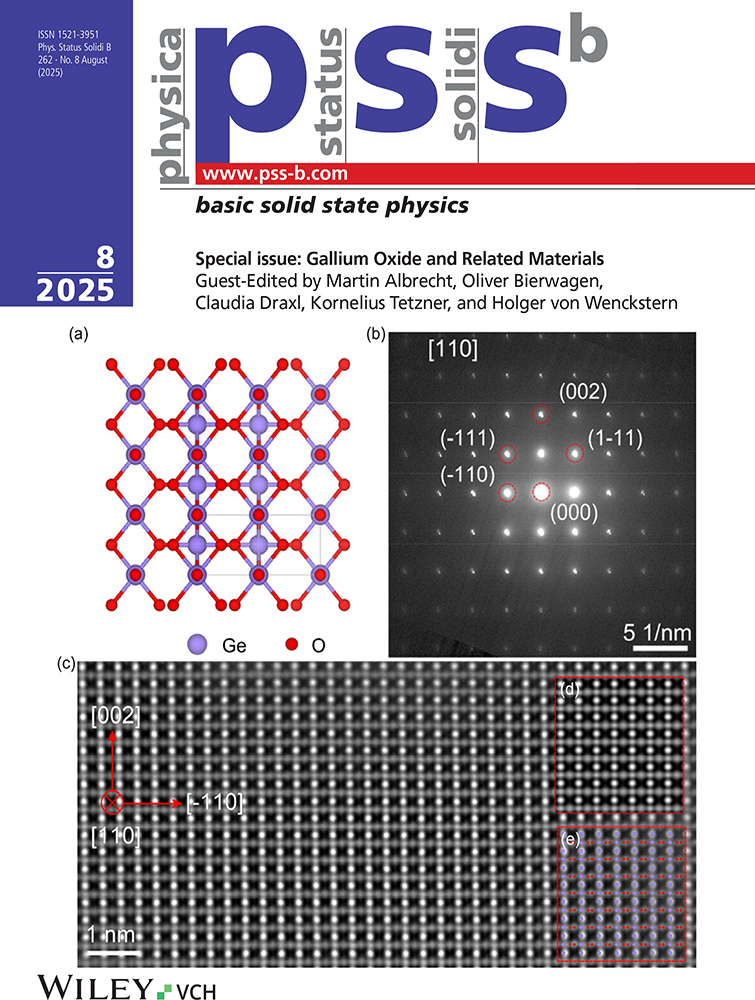Photoluminescence Study of the Gallium Defect Spectrum at ≈ 0.928 ev (ga3) in Irradiated Silicon
Pfaffenwaldring 57, D-7000 Stuttgart, FRG.
Abstract
enA detailed investigation is made of the Ga3 luminescence spectrum observed in gallium doped silicon after electron irradiation and annealing at ≈ 250 °C. The spectrum exhibits exciton singlet—triplet pair no-phonon transitions at 0.9291 or 0.9272 eV, respectively, and quasi-localized modes of vibration energy 10.3, 24.4, and 56.9 meV along with combination modes and lattice phonon bands. An additional higher energy no-phonon transition is due to an excited exciton state at excess energy of 3.8 meV thermalizing with the singlet—triplet states. The isotropic Zeeman splitting of the triplet (g = 2.00 ± 0.05) shows that the orbital momentum of the excitonic hole is entirely quenched. This and the low thermal dissociation energy of the exciton (16 meV) are used to deduce a strong hole binding energy (≈ 226 meV) whereas the 16 meV energy is attributed to the electron localization. The low electron binding energy is consistent with uniaxial stress measurements which are quantitatively explainable in terms of effective-mass valley—orbit electron states. This defect represents the first example of a luminescent center in silicon which under uniaxial stress exhibits the whole multiplicity of valley—orbit-states. The valley—orbit nature of the electron and the quenching of the hole orbital momentum render a symmetry classification of the defect impossible.
Abstract
deIn Si:Ga tritt nach Elektronenbestrahlung und Ausheilen bei ≈ 250 °C das Ga3-Lumineszenzspektrum auf, das hier eingehend untersucht wird. Das Spektrum zeigt exzitonische Nullphonon-Übergänge bei 0,9291 (Singulett) und 0,9272 eV (Triplett) sowie quasi-lokalisierte Gitterschwingungen mit 10,3; 24,4 und 56,9 meV Quantenenergie neben Kombinationsschwingungen und ungestörten Gitterphononen. Ein zusätzlicher Nullphononübergang mit 3,8 meV höherer Energie als Ga3 (t) gehört zu einem angeregten, thermalisierenden Exzitonenzustand. Die isotrope Zeeman-Aufspaltung des Tripletts (g = 2,00 ± 0,05) zeigt, daß das Bahnmoment des Lochs voll-ständig unterdrückt ist. Zusammen mit der niedrigen thermischen Dissoziationsenergie des Exzitons (16 meV) kann auf eine hohe Loch-Bindungsenergie von ≈ 226 meV geschlossen werden, während die 16 meV der Lokalisierung des Elektrons zugeordnet werden. In Übereinstimmung mit dieser geringen Bindungsenergie können die Druckmessungen quantitativ mit der Theorie für Effektiv-Masse-Zustände erklärt werden. Dies ist das erste Beispiel eines lumineszierenden Defektes in Silizium, bei dem unter Druck die volle Mannigfaltigkeit der „valley—orbit”︁-Zustände beobachtet werden kann. Andererseits wird hierdurch und durch die vollständige Unterdrückung des Loch-Bahnmoments eine Symmetriebestimmung des Zentrums verhindert.




